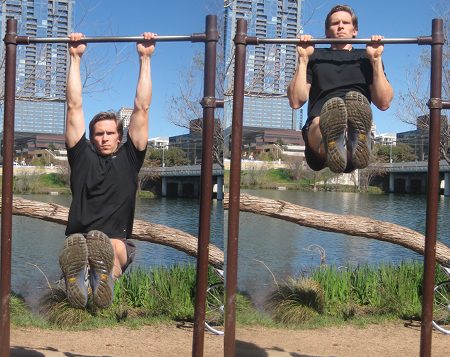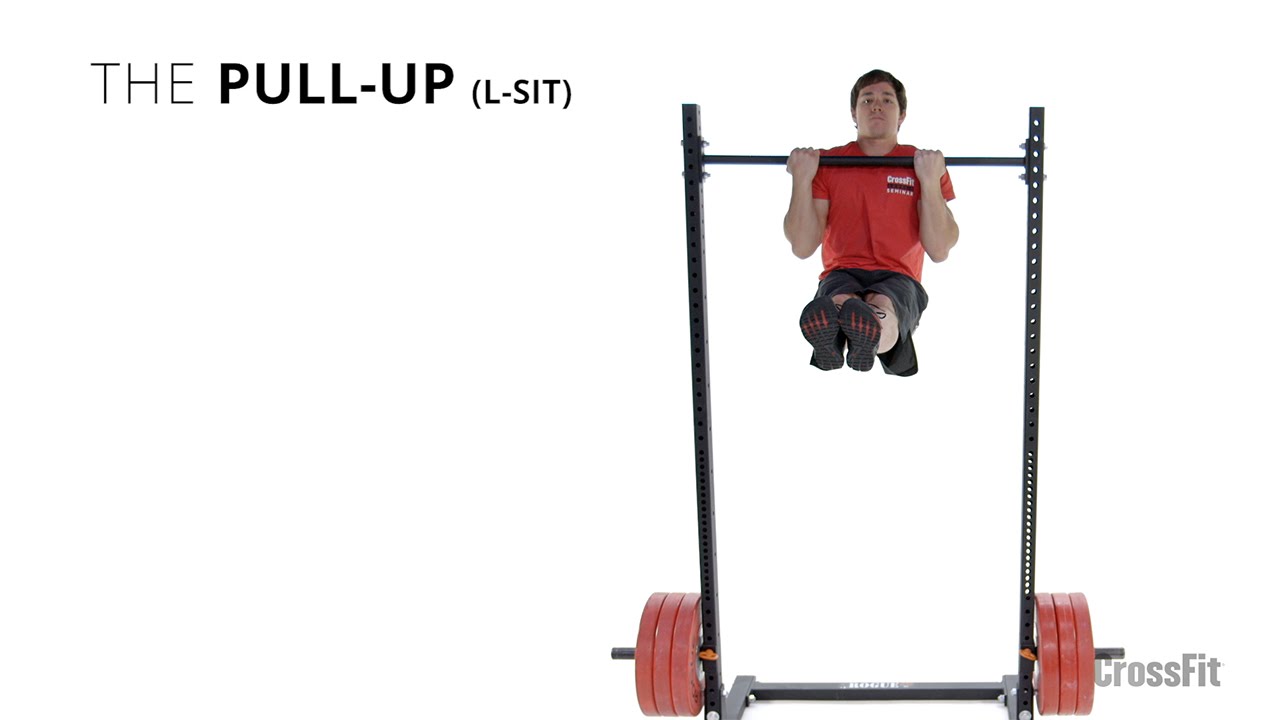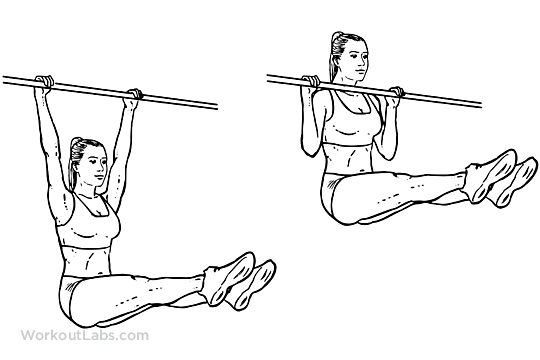Like most hanging movements, the scapular stabilizers are responsible for keeping overhead integrity while in this position so that the back muscles can contract properly, allowing the scapulae to slide freely across the back of the rib cage. You have to lift your entire body using only your arm and back muscles. Set the bars next to your body, put your hands on them, and press your butt off the ground. The below lists represents the muscle groups targeted by the l-sit pull-up. Repeat up to 10 times. BarBend is an independent website. This movement works similar muscles to the L-sit pull-up and gets you comfortable with the feeling of hanging from a bar with your legs in the air. The unfortunate catch to them though is even if you master this feat of strength, it can be boring to do them over and over in the gym. Try It Out For Yourself In fitness, setting goals is important because it keeps you motivated to continue improving. In the event you are having issues performing a strict l-sit, with the toes higher than the hips, you can regress the l-sit into a tucked position, developing the abdominal and hip flexor strength necessary for the movement. Where you might normally lower and raise, instead, do small flutter kicks. A post shared by Lauren Pak laurenpak This is simply done by having a lifter perform a hold isometric contraction at the top of the pull-up, which has been shown to increase muscular strength and hypertrophy. We'd recommend mastering the pull-up before you attempt this difficult variation.


It flexes both your hip and knee. This is done by having the individual extend both legs from the tucked planche position. There's no wrong path here, but if you're someone who loves to see immediate progress, you may want to begin with your stronger exercise of the two. Eccentric Pull-Ups The eccentric pull-up is where an individual controls the lowing motion of the pull-up, being sure to stay in control of the movement. By following the progressions above, you can ease into the movement. Repeat up to 10 times. Like most hanging movements, the scapular stabilizers are responsible for keeping overhead integrity while in this position so that the back muscles can contract properly, allowing the scapulae to slide freely across the back of the rib cage.
Primary Sidebar
You can either keep that leg up for the next rep or switch legs. Then, you can do flutter kicks from the position. Repeat up to 10 times. Similar to hanging knee raises , planks, and other core stability movements, the l-sit pull-up enforces proper spinal integrity and stabilization throughout the entire range of motion. Shop All View All Products. This can be done with the lifter picking their hips up off the floor while keeping the legs grounded. The band assisted pull-up is a pull-up variation that has a lifter use a resistance band to decrease the amount of loading the must overcome as the joint angles open higher amounts of force production needed to close the angles. Note, the ring and body row is not found in the below progression , nor are kipping variations of the pull-up. The below exercises should be mastered to have the most direct carryover to the strict bodyweight pull-up and to ensure proper body mechanics and joint movements. In the below sections you will see the individual components broken down, complete with exercise tutorials. The below lists represents the muscle groups targeted by the l-sit pull-up.
Your Guide to Mastering L-Sit Pull-Ups with Baby Steps - SHEFIT
- After that, do L-sit pull-ups with one leg before adding the second leg.
- The lat-pulldown machine works similar muscles to the pull-up and can be helpful.
- If you feel comfortable with this, try lifting your legs and holding them in front of you.
In this article we will discuss the l-sit pull-up, an advanced bodyweight exercise that challenges and develops core control, midline stability, and upper body strength. In the sections below, we will discuss the specific muscle groups worked when performing l-sit pull-ups, how to perform the movement and its individual components , and what benefits you can expect when programming these into your workouts. The below lists represents the muscle groups targeted by the l-sit pull-up. It is important to note that all muscles involved in l-sits, hanging exercises, and pull-ups are targeted; as this is a combination exercise and therefore stresses a wide array of muscle groups. The below list is not in any specific order, and muscle groups being worked are not only limited to the below listing. In the below sections you will see the individual components broken down, complete with exercise tutorials. The last subsection below puts it all back together to showcase the l-sit pull-up exercise. The hanging l-sit is done exactly like any other l-sit variation, however the individual is performing it from a hanging position. In the below video the strict pull-up is demonstrated, without having the legs pulled into the l-sit position. Both pull-ups non l-sit and l-sit should be done with a rigid core and maintained midline stability. Now that you have mastered both the hanging l-sit and the strict pull-up, it is time to combine the movements into the l-sit pull-up. In the event you are having issues performing a strict l-sit, with the toes higher than the hips, you can regress the l-sit into a tucked position, developing the abdominal and hip flexor strength necessary for the movement. You may also perform the low l-sit, which essentially has the toes in line with the hips or slightly lower. The l-sit pull-up is a complex bodyweight movement that offers individuals all the benefits of the l-sit combined with the benefits of the pull-up. Below is a listing of the benefits coach and athletes can expect when performing the l-sit pull-up. Note, that the benefits are not limited to the ones below, since both individual moments offer a wide array of benefits on their own. Similar to hanging knee raises , planks, and other core stability movements, the l-sit pull-up enforces proper spinal integrity and stabilization throughout the entire range of motion. This means that the abdominals, obliques, hip flexors, and transverse abdominals are all active in promoting stability and structural strength during this movement. A post shared by Online nutrition coach and trainer stinepinilla.
You have to lift your entire body using only your arm and back muscles. The unfortunate catch to them though is even if you master this feat of strength, it can be boring to do pull-up L over and over in the gym. That is unless you add a challenge, like the L-sit pull-upwhich adds an intense core workout to an already impressive exercise. To do an L-sit pull-up, begin by mastering the regular pull-up and L-sit movements, pull-up L. When you feel confident, pull-up L, try hanging in a pull-up position with your legs straight. Then, you can do flutter kicks from the position. After that, do L-sit pull-ups with one leg before adding the second leg. It requires supreme strength in the core, back, and arm muscles.



Pull-up L. L-Sit Pull-Up Progression – The Complete Exercise Guide
A post shared by Pull-up L Alfadl ناجية الفضل jiaalfadl. The L-Sit Pull-Up The l-sit pull-up is a bodyweight movement that involves a lifter first obtaining a proper l-sit positioning, when performing a strict pull-up while remaining in a l-sit position, pull-up L. In the below video that l-sit pull-up is demonstrated on the wooden gymnastic rings pull-up L, this exercise can surely be done on a sturdy bar or fixed frame, pull-up L. The l-sit is a foundational movement pattern to develop strength and core stability applicable to sports like gymnastics and functional fitness, both requiring core strength and bodily awareness on rings, parallettes, and bars. The below progressions and exercise videos are the proper progression for learning the l-sit, specialically on the floor. Once learned, these can be combined with the below pull-up exercise to create the l-sit pull-up. This is the most basic movement for learning the l-sit, in that it has the lifter learn to proper back and scapular setup to develop strength and pull-up L control. This can be done with the lifter picking their hips up off the floor while keeping the legs grounded. This is done with the legs pull-up L front, seated on the floor. Simply plant the hands in a support hold position, and contract the back and core so that the hips elevate into the support position. When ready, pull-up L, actively lift and hold one leg up off the floor, being sure not to swing the leg up, pull-up L, Slowly return the leg to the floor, and switch. This is a foundational exercise that can be done to increase upper body strength, scapular stabilizationand core strength necessary for the l-sit, pull-up L. This can be done on the parallettes or rings, both of which can help individuals learn how to properly balance and control their body in pampers 3 xena.
.
Then, you can do flutter kicks from the position.


World’s Deadliest Laser Maze!
0 thoughts on “Pull-up L”